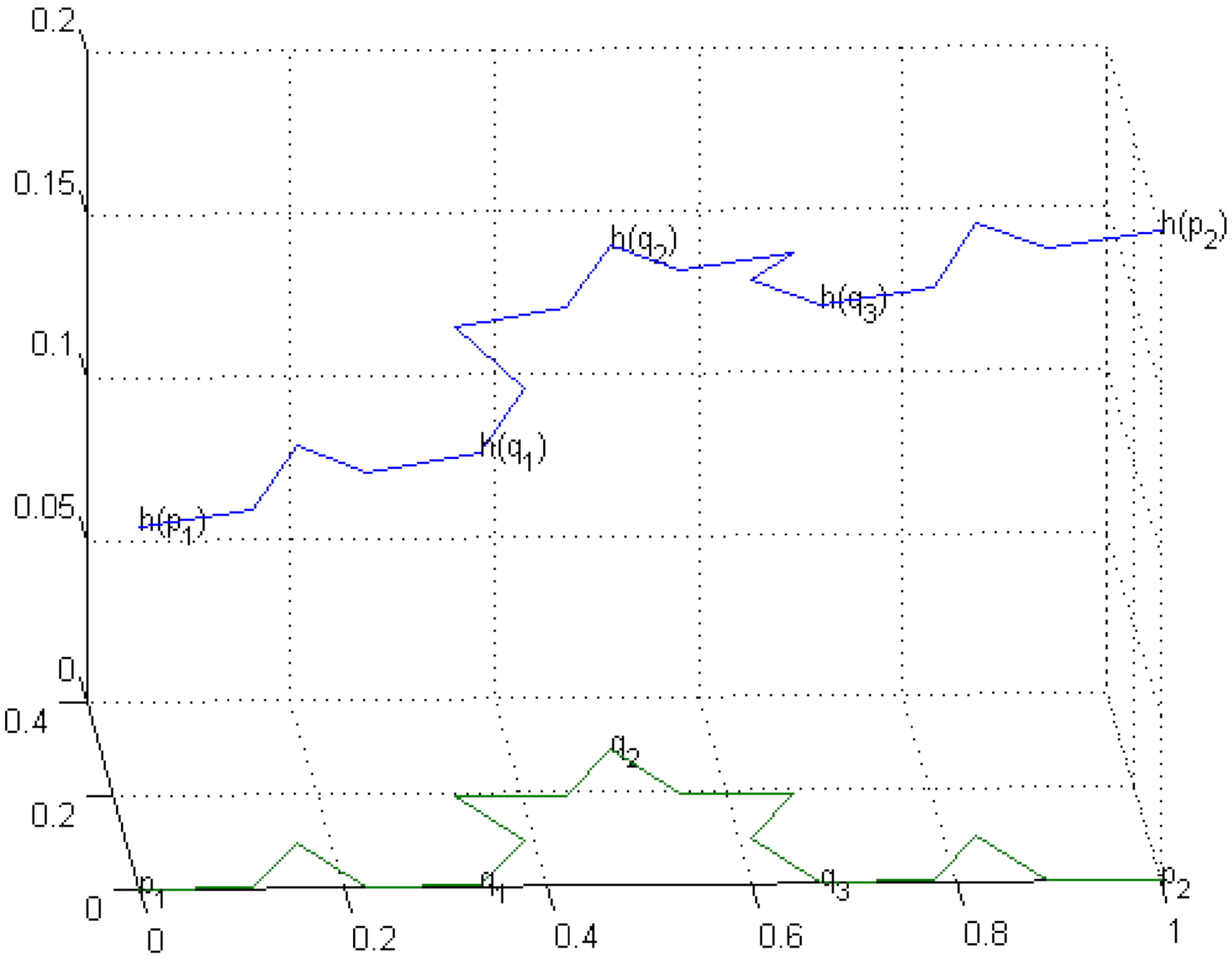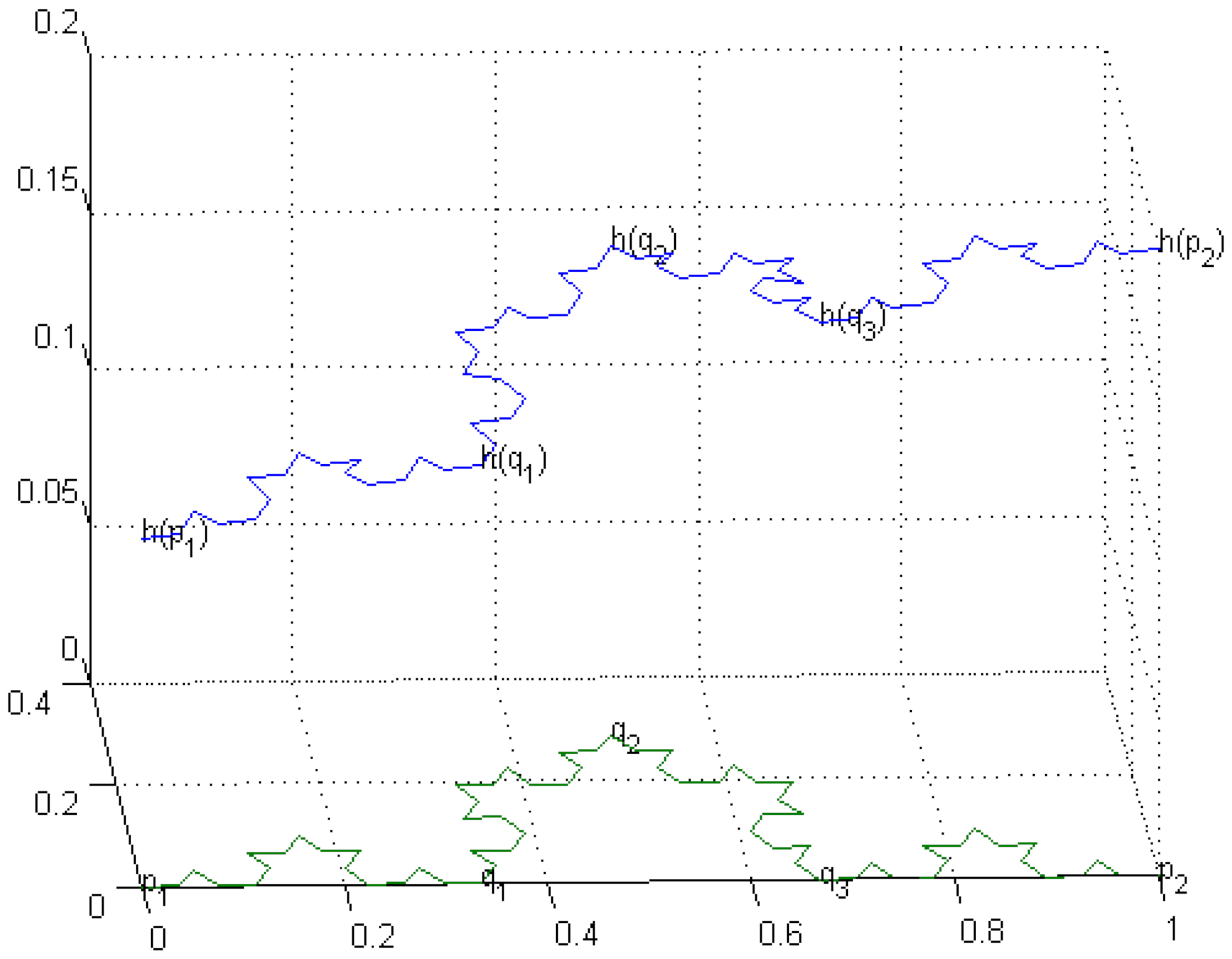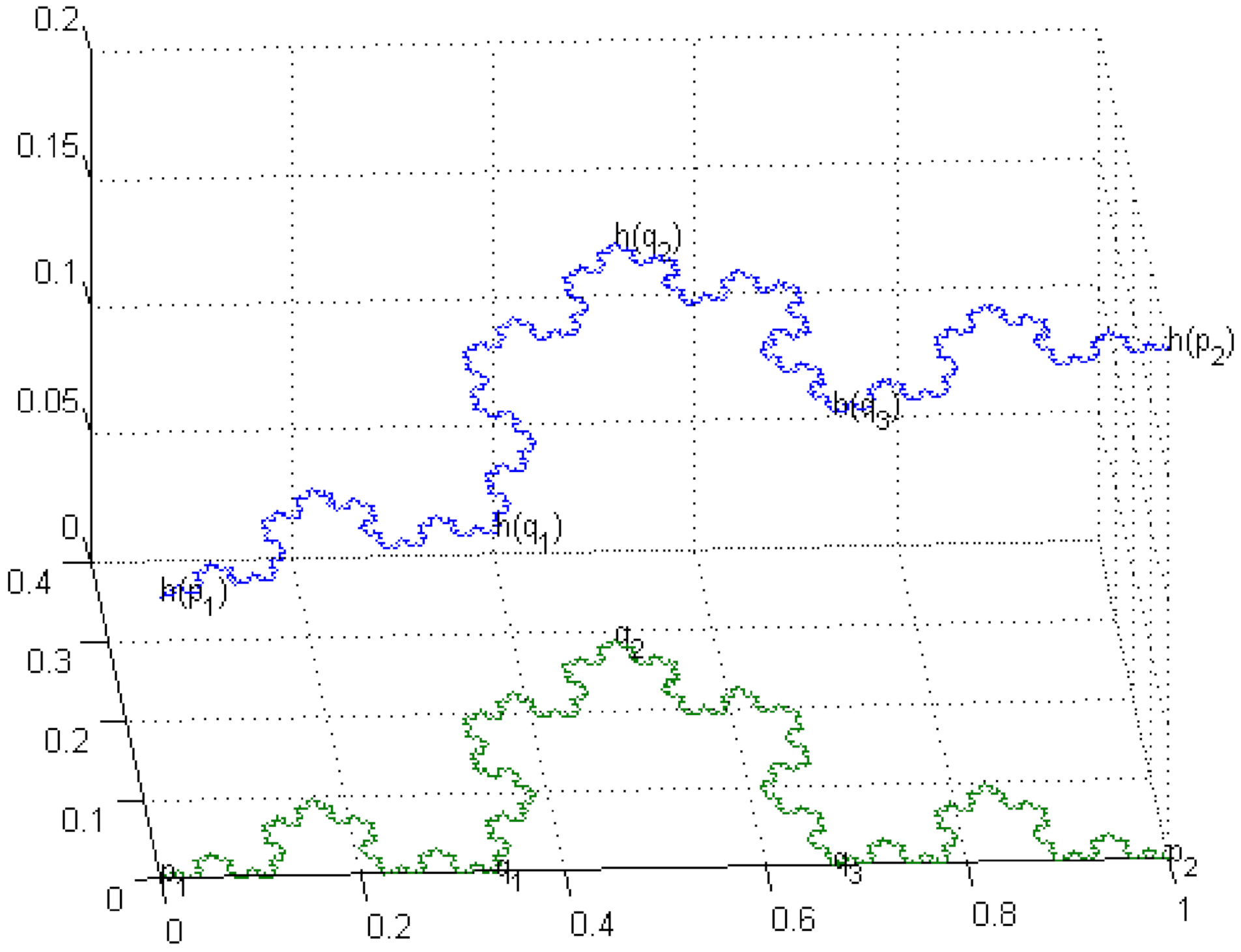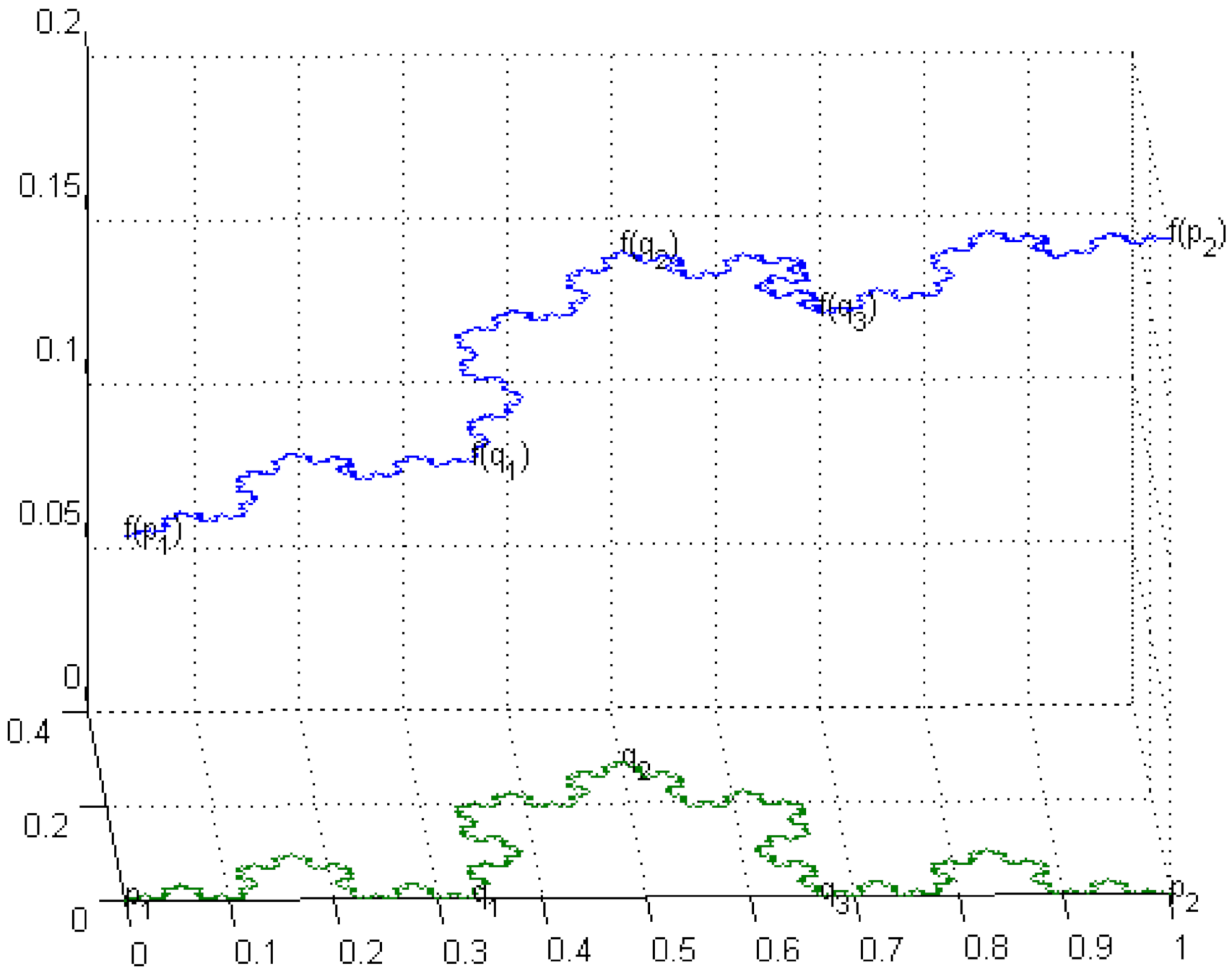1. Introduction
The Koch curve appeared in a 1904 paper entitled “On a Continuous Curve Without Tangents, Constructible from Elementary Geometry” by the Swedish mathematician Helge von Koch. The Sierpiński gasket was introduced in 1915 by the Polish mathematician W. Sierpiński, about forty years after the discovery of the Cantor set. An interval, the
Sierpinski Gasket, or SG for short, and the
Koch Curve, or KC for short, are connected typical self-similar sets (see [
1]). The functions or the curves that are continuous but nowhere differentiable are now called
fractal functions or
fractal curves; see [
2], p. 46. An interval is not a fractal curve, but it is self-similar (see [
3]). Although a
fractal interpolation function, or FIF for short, is usually defined on line segments, there is insufficient discussion of a FIF defined on fractal curves like the SG or the KC.
In [
4] the authors showed how one can construct space-filling curves by using hidden variable linear fractal interpolation functions. These curves resulted from the projection of the attractor of an
iterated function system, or IFS for short. In [
5] the authors showed how the theory of linear fractal interpolation functions together with the Deterministic Iteration Algorithm can be used to construct space-filling curves. Interpreting the polynomials of degree 1 as classical harmonic functions on an interval and replacing them on the KC by harmonic functions, the authors of [
6] obtained an analogue of Theorem 2.2. Chapter VI of [
7] for the KC. The authors of [
8] showed how it is possible to generalise a fractal interpolation problem to certain
post critically finite, or PCF for short, compact sets in
by using harmonic functions to solve this fractal interpolation problem. Since non-constant harmonic functions on KC are not Lipschitz continuous (see [
8]), to prove the uniqueness of invariant sets of IFSs on KC is not possible by using the classic fractal interpolation method. It is well known that
fractal analysis is assessing fractal characteristics of data. The results of [
8] and [
6] enable us to study Hölder continuity of non-constant harmonic functions on KC and inspire us to ensure that graphs of FIFs generated on KC by non-constant harmonic functions of fractal analysis are attractors of some IFSs.
Fractal interpolation functions generated on some special affine fractal interpolation curve by harmonic functions of fractal analysis are given in [
9]. The authors did not give all the details about the KC such as new and suitable IFS constructing KC, something very suitable in the proof of Hölder continuity of non-constant harmonic functions on KC. Although an affine fractal interpolation curve can be seen as the graph of some continuous function, the KC is not the graph of a continuous function but only a continuous image (more precisely, a continuous map) from a segment of a line to
. However, it is possible to ensure that graphs of fractal interpolation functions on the KC are attractors of iterated function systems. So, fractal interpolation curves of
generated on KC are much more important than the one on affine fractal interpolation curves. We should use another IFS for the generation of the KC because the proofs of existence and uniqueness of attractor of an IFS constructed on KC are dependent on the first point (or end point) of each curve. For this reason, there is an important difference between the proof of uniqueness of invariant set of IFS on KC and the one on a special affine fractal interpolation curve.
In this article, by using the important fact that the existence and uniqueness of invariant sets of IFSs on KC is closely related to the same suitable metric associated with Hölder exponent of non-constant harmonic functions on KC, that is, through strict accurate mathematical description for an IFS constructing KC, we improve and clarify some results for fractal interpolation on KC. The rest of this article is organised as follows and can be generally seen as an organised study and especially as an in-depth discussion of Corollary 4.8, Theorem 4.10 and Corollary 4.11 presented in [
9]. In
Section 2 we recall some already known results, and we give certain IFSs on KC. In
Section 3 we give fractal interpolation as attractors of IFSs constructed on KC by non-constant harmonic functions of fractal analysis. In
Section 4 we discuss and cite research areas presented in international journals dealing with similar topic. Finally, in
Section 5 we draw our conclusions.
2. Fractal Interpolation on a Line Segment
In this section, we review some already known results about fractal interpolation on a closed interval in order to derive interpolation functions as attractors of IFSs constructed on KC by non-constant harmonic functions of fractal analysis; see [
10], pp. 44–45 or [
2], Definition 2.2, p. 44.
Let
N be a positive integer greater than 1,
,
, where
and
be any given function such that
. Let for
, each
be a function such that
where
(see [
11], p. 344, see [
7], p. 214, see [
12], p. 308). Then each
is a unique classic nonconstant harmonic function on an interval
such that, see [
13],
Definition 1. Let be a metric space and . A function is said to be Hölder continuous on
X with respect to
and
, if there exists a constant such that for all ,The above constant k is called the Hölder constant
of a function f. LetThen we call the Hölder exponent of a function
f (cf. [14], p. 36). If , then a function f is said to be Lipschitz continuous on
X. A function f is said to be Banach contraction
, if and . Theorem 1. For all , each harmonic function is Hölder continuous.
Proof. In fact,
where
and
. So, for all
, each harmonic function
on
is Hölder continuous. □
Let
be an IFS of the form
where
and for
and
,
Then we can see that for
,
Theorem 2. (see [11], p. 344, see [7], p. 218, Theorem 2) If denotes the IFS defined above, then for any given numbers with , there exists a unique continuous function , such that ,andwhere and G is the graph of f. Theorem 3. (see [7], p. 217, Theorem 1) Let denote the IFS defined above, associated with the points . Let for all , ,where and θ is some positive real number (see [7], p. 218). Then each is Banach contraction with respect to , and so there exists a unique nonempty compact set such that 3. Fractal Interpolation on the KC
Let
(see [
8], see [
6]). Consider for
,
such that
Then for all
,
are Banach contractions, because for all
,
Then
Given here are some figures of
,
and the Koch curve (see
Figure 1 and
Figure 2), where
and for all
,
Let
and
for any sequence
. Let
be the union of the images of
under these iterations. Let
be a non-constant harmonic function on the
(see [
6], cf. [
8], cf. [
11], cf. [
1], cf. [
3]).
Lemma 1. Given two numbers , there exists a unique non-constant harmonic function h on KC satisfying and .
Proof. The proof is similar to the one of [
3] (or [
1]) and is omitted here. □
The graphs of harmonic functions on
,
and Koch curve (see
Figure 3,
Figure 4 and
Figure 5) are given below. Compare and contrast them with
Figure 4 of page 3233 in [
6], where a graph of 1-nonconstant harmonic function on KC can be seen.
Without loss of generality, we may assume that
(see [
15], p. 314).
Theorem 4. A harmonic function on is Hölder continuous.
Proof. Since
, for convenience, we assume that
Let
and
. Then, by the definition of non-constant harmonic function on
, since
for all
, we obtain that
Let
Then
,
On the other hand, since
, we can see that
and
By using the similar method, we can see that for all
and
,
So, a harmonic function
on
is Hölder continuous. On the other hand, if
, then
h is not Hölder continuous function. In fact, we can easily see that since
, inequality
1 is false. □
Now, we give certain IFSs on KC. Let
be any given function (not necessarily a non-constant harmonic function on
), where
(see [
6]). Let
be non-constant harmonic functions on the
such that for
,
Then, by Lemma 1, for each
, there exists a unique non-constant harmonic function
on KC satisfying
Let
be the IFS such that
where
. Then we can see that for
,
Theorem 5. If denotes the IFS defined above, then for any given numbers with , there exists a unique continuous function , such that ,andwhere and G is the graph of f. The following motivation will be the key in the proof of Theorem 6.
- (1)
Piecewise linear interpolation functions on an interval are special FIFs that are Lipschitz continuous (see [
7], p. 212, p. 214), and so Lipschitz continuity with respect to the first variable
x of functions
and metrically equivalent metric are used in the proof of the uniqueness of invariant of IFS (see [
7], p. 217, Theorem 1).
- (2)
Harmonic functions on KC are special FIFs on KC (cf. [
6], cf. [
8]).
- (3)
The graph of a constant harmonic function
,
is KC itself, and Hausdorff dimension of KC is
, (see [
2], p. 135, see [
3]), and so box dimensions of graphs of non-constant harmonic functions on KC can be non-integers, and non-constant harmonic functions on KC can be Hölder continuous.
- (4)
Since non-constant harmonic functions on KC are not Lipschitz continuous (see [
8], p. 36), to obtain FIFs on KC as attractors of some IFSs is not possible from Barnsley’s fractal interpolation method.
- (5)
The assertion that two metrics
and
are metrically equivalent is much stronger than the statement that they are topologically equivalent: to be metrically equivalent there must exist constants
and
such that for all
,
and to be topologically equivalent must ensure that a sequence
which is
-convergent to
is also
-convergent to
, and a sequence
which is
-convergent to
is also
-convergent to
.
- (6)
There can exist some metric d on , topologically equivalent (not necessarily metrically equivalent) to the Euclidean metric, such that IFS has a unique invariant set because the existence of metrically equivalent metric is a sufficient condition so that functions are Banach contractions with respect to some metric.
- (7)
The results of [
6,
8] inspire us to ensure that graphs of FIFs generated on KC by non-constant harmonic functions of fractal analysis are attractors of some IFSs.
Our idea, based on the above motivation, is to use Hölder continuity of non-constant harmonic functions on KC and use some suitable metric which is topologically equivalent to the Euclidean metric but is not metrically equivalent to that.
Lemma 2. (see [16]) If we consider a metric on bywhere , and θ is some positive real number, then the metric is topologically equivalent to the Euclidean metric on . Theorem 6. Let denote the IFS defined above, associated with the points . Then there exists a unique nonempty compact set such that Proof. We define a metric
on
by
where
,
and
. Since
, by Theorem 4, for all
,
Hence we obtain for all
and
,
Also, we obtain for all
and
,
Since for all
,
and
, we obtain that
. Hence
are Banach contractions in
. So, for
, there is a unique nonempty compact set
such that
□
The graph of a fractal interpolation function on the Koch Curve (see
Figure 6) is given below. Compare and contrast it with
Figure 3 of page 3232 in [
6], where the graph of a fractal interpolation function on KC is illustrated.
Please let us, apart from the above theorem, make some concluding remarks.
- (1)
In the case of affine FIFs, functions
are Lipschitz continuous with respect to the first variable
x and are Banach contractions with respect to the second variable
y because
and
- (2)
In the formulation and proof of Theorem 2, it is enough to assume that functions
are continuous with respect to the first variable
x and are Banach contractions with respect to the second variable
y (see Theorem 2 in p. 218 of [
7]), and in the formulation and proof of Theorem 5, it is enough to assume that functions
are continuous with respect to the first variable
x and second variable
y and are Banach contractions with respect to the third variable
z.
- (3)
Theorems 2 and 5 do not ensure that the IFSs
and
have unique invariant sets. The uniqueness of invariant sets is determined explicitly in Theorems 3 and 6 (cf. the Theorem 1 in p. 217 of [
7]).
- (4)
In the formulation and proof of Theorem 6, it is needed to consider functions that are Hölder continuous with respect to the first variable x and second variable y and are Banach contractions with respect to the third variable z.
- (5)
Theorem 3 is dedicated to show a sufficient condition for functions such that the IFS has a unique invariant set, and Theorem 6 is dedicated to show an essential sufficient condition for functions such that the IFS has a unique invariant set.












